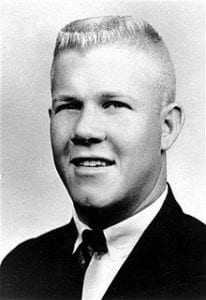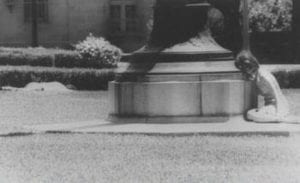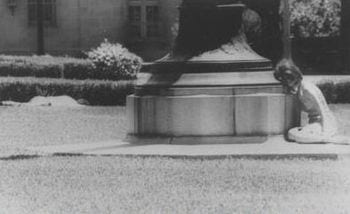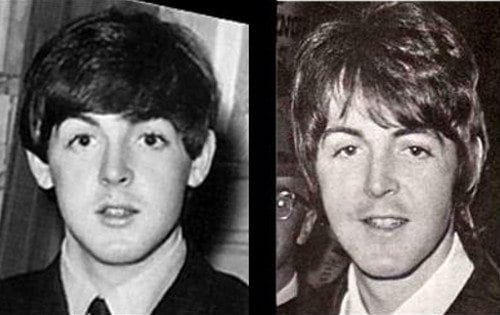 On August 1, 1966, after stabbing his mother and his wife to death, Charles Whitman, a former Marine sharpshooter, took rifles and other weapons to the observation deck atop the Main Building tower at the University of Texas at Austin, then opened fire on persons indiscriminately on the surrounding campus and streets. Over the next 90 minutes he shot and killed 14 people (including one unborn child) and injured 31 others; while a final victim died in 2001 from the lingering effects of his wounds. The incident ended when police reached Whitman and shot him dead. As of March 2018, the attack is ranked as the eighth-deadliest mass shooting in U.S. history. (Source)
On August 1, 1966, after stabbing his mother and his wife to death, Charles Whitman, a former Marine sharpshooter, took rifles and other weapons to the observation deck atop the Main Building tower at the University of Texas at Austin, then opened fire on persons indiscriminately on the surrounding campus and streets. Over the next 90 minutes he shot and killed 14 people (including one unborn child) and injured 31 others; while a final victim died in 2001 from the lingering effects of his wounds. The incident ended when police reached Whitman and shot him dead. As of March 2018, the attack is ranked as the eighth-deadliest mass shooting in U.S. history. (Source)
The Wikipedia entry for Charles Whitman confirms he too, like almost every mass shooter in history was on some type of psychiatric prescribed drug:
Investigating officers found that Whitman had visited several University doctors in the year before the shootings; they prescribed various medications for him. Whitman had seen a minimum of five doctors between the fall and winter of 1965, before he visited a psychiatrist from whom he received no prescription. At some other time he was prescribed Valium by Dr. Jan Cochrum, who recommended he visit the campus psychiatrist.
Whitman met with Dr. Maurice Dean Heatly, the staff psychiatrist at the University of Texas Health Center, on March 29, 1966. Whitman referred to his visit with Heatly in his final suicide note, writing, “I talked with a Doctor once for about two hours and tried to convey to him my fears that I felt come [sic] overwhelming violent impulses. After one visit, I never saw the Doctor again, and since then have been fighting my mental turmoil alone, and seemingly to no avail.”
Heatly’s notes on the visit said, “This massive, muscular youth seemed to be oozing with hostility […] that something seemed to be happening to him and that he didn’t seem to be himself.” “He readily admits having overwhelming periods of hostility with a very minimum of provocation. Repeated inquiries attempting to analyze his exact experiences were not too successful with the exception of his vivid reference to ‘thinking about going up on the tower with a deer rifle and start shooting people.'”
Although Whitman had been prescribed drugs and was in possession of Dexedrine at the time of his death, the toxicology was delayed because Whitman had been embalmed on August 1, after his body was brought to the Cook Funeral Home in Austin. However, an autopsy had been requested in the suicide notes left by Whitman and was then approved by his father. (Wikipedia)
The day before the shootings, Whitman bought a pair of binoculars and a knife from a hardware store, and some Spam from a 7-Eleven convenience store. He picked up his wife from her summer job as a telephone operator before he met his mother for lunch at the Wyatt Cafeteria, which was close to the university.
At approximately 4:00 p.m. on July 31, 1966, Charles and Kathy Whitman visited their close friends John and Fran Morgan. They left the Morgans’ apartment at 5:50 p.m. so Kathy could get to her 6:00–10:00 p.m. shift.
At 6:45 p.m., Whitman began typing his suicide note, a portion of which read:
I do not quite understand what it is that compels me to type this letter. Perhaps it is to leave some vague reason for the actions I have recently performed. I do not really understand myself these days. I am supposed to be an average reasonable and intelligent young man. However, lately (I cannot recall when it started) I have been a victim of many unusual and irrational thoughts. These thoughts constantly recur, and it requires a tremendous mental effort to concentrate on useful and progressive tasks.
In his note, he went on to request an autopsy be performed on his remains after he was dead to determine if there had been a discernible biological contributory cause for his actions and for his continuing and increasingly intense headaches. He also wrote that he had decided to kill both his mother and wife. Expressing uncertainty about his reasons, he nonetheless stated he did not believe his mother had “ever enjoyed life as she is entitled to,” and that his wife had “been as fine a wife to me as any man could ever hope to have.” Whitman further explained that he wanted to relieve both his wife and mother of the suffering of this world, and to save them the embarrassment of his actions. He did not mention planning the attack at the university.
Just after midnight on August 1, Whitman drove to his mother’s apartment at 1212 Guadalupe Street. After killing his mother, he placed her body on her bed and covered it with sheets. Just how he murdered his mother is disputed, but officials believed he rendered her unconscious before stabbing her in the heart.
He left a handwritten note beside her body, which read in part:
To Whom It May Concern: I have just taken my mother’s life. I am very upset over having done it. However, I feel that if there is a heaven she is definitely there now […] I am truly sorry […] Let there be no doubt in your mind that I loved this woman with all my heart.
Whitman then returned to his home at 906 Jewell Street, where he killed his wife by stabbing her three times in the heart as she slept. He covered her body with sheets, then resumed the typewritten note he had begun the previous evening. Using a ballpoint pen, he wrote at the side of the page:
Friends interrupted. 8-1-66 Mon. 3:00 A.M. BOTH DEAD.
Whitman continued the note, finishing it by pen:
I imagine it appears that I brutally killed both of my loved ones. I was only trying to do a quick thorough job […] If my life insurance policy is valid please pay off my debts […] donate the rest anonymously to a mental health foundation. Maybe research can prevent further tragedies of this type […] Give our dog to my in-laws. Tell them Kathy loved “Schocie” very much […] If you can find in yourselves to grant my last wish, cremate me after the autopsy.
He also left instructions in the rented house requesting that two rolls of camera film be developed and wrote personal notes to each of his brothers.
Whitman last wrote on an envelope labeled “Thoughts for the Day,” in which he stored a collection of written admonitions. He added on the outside of the envelope:
8-1-66. I never could quite make it. These thoughts are too much for me.
At 5:45 a.m. on August 1, 1966, Whitman phoned his wife’s supervisor at Bell System to explain that Kathy was ill and unable to work that day. He made a similar phone call to his mother’s workplace five hours later.
Whitman’s final journal entries were written in the past tense, suggesting that he had already killed his wife and mother.

At approximately 11:25 a.m., Whitman reached the University of Texas at Austin, where he showed false research assistant identification to obtain a parking permit. Whitman wheeled his equipment toward the Main Building of the University. Entering the Main Building, Whitman found the elevator didn’t work. An employee named Vera Palmer activated it for him; Whitman thanked Palmer, stating, “Thank you ma’am”, before repeatedly saying: “You don’t know how happy that makes me.”
Exiting the elevator on the 27th floor, he hauled the dolly and equipment up a flight of stairs to a hallway, from which another flight led to the rooms skirted by the observation deck. There he encountered receptionist Edna Townsley.
Michael Gaddy (LewRockwell.com) reported in 2009:
The 60s were a tumultuous time in America. There were the Vietnam War and its subsequent peace movement; the Kennedy assassinations; the Martin Luther King assassination, and the mass shooting at the University of Texas by Charles Whitman. The high-profile assassinations and the mass shooting prompted the government to lobby for stronger gun control, leading to the passage of the unconstitutional, NRA supported, 1968 Gun Control Act.
With the exception of the Vietnam War and its protest activity, all of the above events played into the hands of the state and its never-ending efforts to disarm private citizens. While the only common denominator in the University of Texas shooting involved the use of mind altering drugs by the shooter, the three assassinations were similar in accusations of Central Intelligence Agency (CIA) involvement was alleged in each of them.
It was reported that President Lyndon Johnson was moved by the University shooting to move for stronger gun control; the facts of the case supported just the opposite. After Whitman killed his mother and wife by stabbing them to death, he went to the University Tower where his next victim, Edna Townsley, a receptionist, was butt-stroked with a rifle, which led to her death. Whitman had in essence killed three people before he pulled the trigger the first time.
When victims began to fall from shots fired by Whitman from the University Tower, several civilians secured weapons from their cars and began to return fire at Whitman along with police on the scene. The combined efforts of these civilians and the police forced Whitman to shoot from waterspouts, greatly limiting his ability to acquire additional targets. Had it not been for the deployment of private arms by civilians, the toll of lives lost and those wounded would have been much larger. Yet, the state used this tragedy to move for more draconian firearms possession limitations on private citizens.
Sources:



